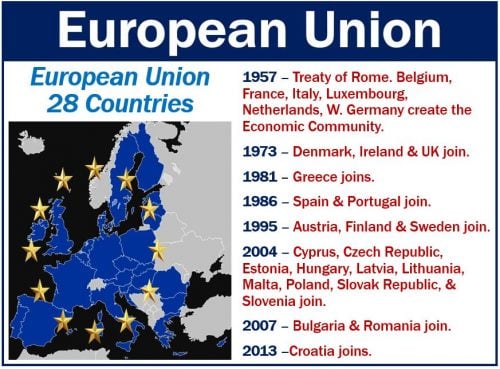What is the European Union (EU)?
The European Union is an economic and political union of twenty-eight European member states. It has developed a single, internal market through a system of standardized laws that apply in every member state. With a population of 510 million, it is the largest consumer market in the world. We often refer to the European Union as the EU.
A person who lives in a European Union member state can travel freely to another member state. Passport controls have been abolished for travel within the Schengen Area. The Schengen Area comprises twenty-six member states.
EU member states trade with each other without imposing tariffs or quotas. A tariff is a tax on, for example, imports. A quota is a limit on how much a country can import.
The British Government has the following definition of the European Union:
“The European Union (EU) is an economic and political union of 28 countries. It operates an internal (or single) market which allows free movement of goods, capital, services, and people between member states.”

European Union member states
In 1957, the Netherlands, Luxembourg, Italy, West Germany, France, and Belgium signed up to the EEC (European Economic Community) or Common Market.
In 1973, the United Kingdom, Denmark, and Ireland became member states. Greece joined in 1981 and then Spain and Portugal five years later.
East Germany joined in 1990 after the unification of East and West Germany. In 1995, Sweden, Finland, and Austria became member states.
In 2004, ten new member nations joined. That year saw its biggest enlargement when Slovenia, Slovakia, Poland, Malta, Lithuania, Latvia, Hungary, Estonia, Czech Republic, and Cyprus joined.
Bulgaria joined in 2007, and Croatia in 2013.

European Union – four institutions
The EU has four key institutions, which together run the union. They are the European Parliament, the European Commission, the Court of Justice, and the Council of the European Union.
The European Commission
The European Commission, which has existed since 1958, is the European Union’s politically independent executive arm. It is responsible for drawing up proposals for new legislation.
The Commission also implements the decisions that the Council of the EU and the European Parliament made.
According to Europa.eu, the European Commission, which is located in Brussels, Belgium:
“Promotes the general interest of the EU by proposing and enforcing legislation as well as by implementing policies and the EU budget.”
It has a President and a team or ‘College’ of Commissioners. There is one Commissioner for each EU member state.
The European Commission also represents the European Union internationally. It speaks on behalf of EU member states in international bodies, especially in areas of humanitarian aid and trade policy.

The European Parliament
The European Parliament is the European Union’s law-making body. It consists of lawmakers who EU voters elect directly every five years.
In the UK, we call the lawmakers Euro MPs (Members of Parliament) or MEPs (Members of the European Parliament).
Together with the Council of the EU, the European Parliament passes EU laws. The European Commission sends proposals to the Parliament. The Parliament then debates them and decides whether or not they become laws.
The European Parliament decides on international agreements and enlargements.
Together with the Council, the European Parliament also establishes the EU budget.
Europa.eu says the following regarding the composition of the European Parliament:
“The number of MEPs for each country is roughly proportionate to its population, but this is by degressive proportionality: no country can have fewer than 6 or more than 96 MEPs and the total number cannot exceed 751 (750 plus the President).”
“MEPs are grouped by political affiliation, not by nationality.”
The Court of Justice
The Court of Justice of the European Union ensures that every EU country interprets EU law in the same way. It also makes sure that they apply the law in the same way.
In other words, the Court of Justice ensures that EU institutions and member states abide by EU law.
The Court of Justice has one judge from each EU nation, as well as eleven advocate generals.
The General Court has forty-seven judges. In 2019, this number will increase to 56, i.e., two judges from each member state.
The governments of EU nations and EU institutions settle legal disputes at the Court of Justice.
Regarding some other functions of the Court of Justice, Europa.eu explains:
“It can also, in certain circumstances, be used by individuals, companies or organizations to take action against an EU institution, if they feel it has somehow infringed their rights.”
The Council of the European Union
The Council of the European Union is the voice of the governments of EU member states. It adopts new laws and policies of the EU.
The Council, which has been around since 1958, consists of government ministers from each EU member state. Its makeup depends on the policy area that members are discussing.
Each EU member state holds the Presidency on a six-month rotating basis.
The Council, together with the European Parliament, is the European Union’s main decision-making body.
Europa.eu says the following about the Council:
“In the Council, government ministers from each EU country meet to discuss, amend and adopt laws, and coordinate policies.”
“The ministers have the authority to commit their governments to the actions agreed on in the meetings.”

